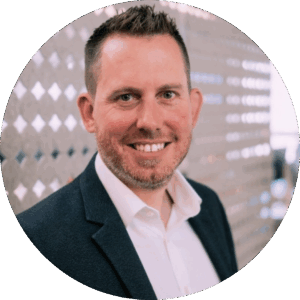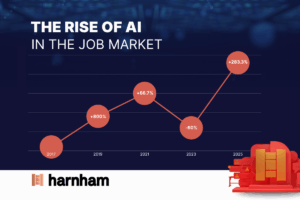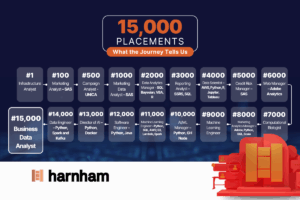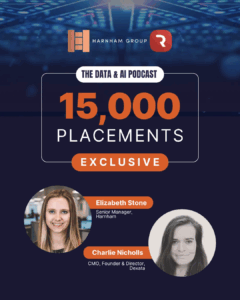 By David Farmer, CEO, Harnham Global
By David Farmer, CEO, Harnham Global
We haven’t just hit 15,000 placements, we’ve launched 15,000 careers, changed 15,000 lives and it’s a marker. A marker of how far the Data & AI industry has come and what it’s taken to get here. From our very first Infrastructure Analyst in 2006 to placing CDOs, Directors of Data, AI Directors and Heads of AI, we’ve been on this journey with the industry since the beginning.
We’ve seen it all: the early days of SAS and SQL, the shift to Python and the cloud, the growth of ethics and governance roles, and the ongoing challenge of finding people who cannot just crunch numbers but tell stories with data. And recently, we have seen another shift – the move from the generic ‘Data person’ role, required to wear multiple hats (analysts, developers, engineers), to more specialised roles with defined purpose such as ‘Data Engineers’ ‘BI Analysts’ and ‘AI engineers’.
Now, we’re sharing intel about what we’ve learned and where we think it’s all going next.
What’s Changed?
Of course, the obvious is the size and scale of the industry. According to ChatGPT, the number of roles in data has grown from 1-2 million in 2006 to somewhere between 15 million and 25 million today. That change has had a huge impact on the roles within the industry, moving the data science role from predominantly academia or statistics-based work to a much broader role within a huge spectrum of industries. The Data scientist title became synonymous with one of the zeitgeist moments of the data boom, with the “need” for a data scientist or the desire to be one coming in advance of a true definition of the role. This was borne out in the data analysis for our salary guides through that period, with candidates with the title Data scientist performing roles which would traditionally have been called Marketing Analyst, CRM Analyst or even Data Governance manager.
The shift in Governance is another ongoing shift. Historically viewed as a compliance / audit function, with the growth of Data and more recently a boom in AI deployment, this role has shifted in scope and placement, moving from an audit position to a centralised role of data stewardship, MDM and AI ethics. The latter will continue to grow, with Cambridge University’s MPhil in Ethics of AI, Data and Algorithms showing what we believe to be a necessary direction of travel.
Day to day, Harnham started out by placing analysts who could build dashboards and run reports. Now, we’re placing AI Engineers, MLOps specialists, and those designing LLMs. The pace has accelerated. The roles are deeper. The stakes are higher. The tools have changed, too. From SAS, Excel and VBA to Docker and Kafka. From structured datasets to messy, real-time, unstructured data. There’s a shift from siloed analytics to fully embedded teams, and from back-office reporting to real-time, business-critical decisions.
In further articles we will focus in on individual roles, responsibilities and titles to highlight the shift seen within each part of the industry.

The graph shows the percentage increase or decrease in the number of roles Harnham has filled with ‘AI’ in the job title over the years.
What Hasn’t Changed?
One thing that’s remained consistent: the ability to take what the data is saying and tell someone else about it in a way that matters. That’s always been the difference-maker. It’s never just been about the code or the model – it’s about translating complex insights into business action. Finding people who can bridge that gap, who can make sense of numbers and influence decision-making, remains one of the toughest challenges, just like it was when we started.
We will be covering this in a whitepaper, which will be available soon.

Yes, there’s growing demand for Chief AI Officers and Directors of AI. But our 15,000th placement? A Rockborne-trained Business Data Analyst. Proof that the next generation coming through still underpins it all. Looking at that role and candidate in more detail tells us a lot about how the industry has moved.
Meeting Abby, candidate 15,000, we learned that no one day is the same – some days the focus is all about engaging and presenting to stakeholders, other days focus on managing projects, diving into code to help teams out, building power BI dashboards for clients, and other days the focus is to study data lineage and architecture diagrams.
That breadth of skill is something companies seek at the junior talent levels, so the breadth of training Abby went through prior to her starting in role has enabled her to be more successful.
Her ability to communicate complex outcomes in a clear business language and easy to understand way highlights the importance of the story telling point from earlier.
Overall though, these 15,000 candidates don’t just highlight a tech journey. They show a story of capability. A move from reporting to real-time insight. From projects to products. From centralised teams to embedded ones. Some things change. Some things stay the same.
For Candidates: The Shifting Landscape
- It’s not about having the perfect CV anymore. It’s about showing you can learn, adapt, and apply.
- People who started as SAS programmers are now AI Architects. That shift didn’t happen overnight, and it didn’t happen by accident.
- Lifelong learning isn’t a buzzword. It’s the reality. Be prepared to talk about your engagement in learning.
- The average CDO will want to see actual demonstrations of work outside of your CV. If you’re a tableau analyst it is important not just to show dashboards you have built, but just as important to talk about what the outcome from those dashboards was.
For Businesses: Solutions Over Tools
- The best companies start with the problem, not the job title. They figure out what they need to solve and then hire someone to do that.
- Hiring in layers works. We’ve seen it — data engineers, AI leads, and governance heads.
- Governance isn’t optional anymore. Neither is training. Whether it’s upskilling your own teams or bringing in early-career consultants, you have to be thinking long-term.
What’s Next?
To celebrate 15,000 placements, we’ll be sharing a range of insights and interviews with clients, candidates and others from our Harnham network over the years, including a live panel discussion on what’s next for the industry. Watch this space.
Check out our 15,000 placements exclusive podcast:
 The Data & AI Podcast: 15,000th Placement Exclusive with Charlie Nicholls from Dexata: LISTEN HERE
The Data & AI Podcast: 15,000th Placement Exclusive with Charlie Nicholls from Dexata: LISTEN HERE
To mark Harnham’s 15,000 placements, Elizabeth and Charlie reflect on how data talent, technology, and customer expectations have evolved over the past two decades, and what that means for the future of work and experience design.
- What it takes to get personalisation right at scale
- How AI is reshaping the workplace and decision-making
- The role of experimentation in creating human-centric experiences
- Why customer experience optimisation is more critical now
Connect with us on LinkedIn to learn more about our 15,000 journey: HERE
Are you ready for AI?
In a landscape dominated by discussion of AI, companies can find it hard to navigate the marketplace.
Download our “AI Hiring How-to Guide” for insights on key roles, salaries and more:
How to Hire in AI: Harnham's "How To" Guide
Sign up to download your guide:

























